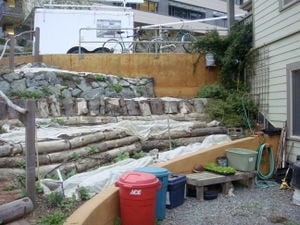
This page was created for two reasons:
- to describe the current gravity fed drip irrigation system located at the Cal Poly Humboldt Campus Center of Appropriate Technology in Arcata, California
- to suggest recommendations that would increase the performance of the current system. This page was created as part of the class requirements for Engineering 115 Fall 2009 taught by Dr. Dustin Poppendieck. Please note that another CCAT gravity fed drip irrigation page exists. The CCAT Gravity Fed Drip Irrigation link on Appropedia describes the original system construction by a Engineering student in 2008. The existing system is pictured in Figure 1.
Overview of Existing System[edit | edit source]
Arcata receives most of its rainfall between November and April and has an average rainfall of about 5 inches during these months.[2] The existing gravity fed drip irrigation system located at CCAT is intended to be used during the summer months when rain is scarce. The irrigation system has a storage unit consisting of a five gallon bucket. The storage bucket is attached to a retaining wall located on the uphill side of the garden (Figure 2). Water is manually placed in the storage bucket. An outlet is located at the bottom of the storage bucket to allow water to flow into a 0.5 inch main water line. The main water line is split via a T-fitting immediately upon exiting the storage bucket (Figure 3). The T-fitting allows water to be delivered to a pair of ten meter long main water lines. The two main water lines are designed to simultaneously deliver water to several plants via 1/4" lateral lines branching off from the main water lines. The main water lines each have between fifteen and twenty lateral lines. The lateral lines are attached to the main water line using emitters. The objective of this design is to allow irrigation water to be efficiently delivered to several plants in multiple beds simultaneously. The irrigation water in the main water lines is blocked from exiting the terminal end of each main water line in order to direct the flow to the lateral lines of the system. The blockage of flow is achieved using clamps attached at the end of each main water line (Figure 4). The system is designed to allow the two main water lines to be manually moved to fed a series of four terraced garden beds. Each of the four beds has a surface area of about ten square meters and a depth of about one meter.
-
Figure 2: The existing 5-gallon storage bucket is the system's water source. The storage bucket is mounted to the retaining wall above garden beds.[1]
-
Figure 4: The hose clamp used for the gravity fed drip system.[1]
-
Figure 3: The T-fitting located at the storage bucket outlet splits the main water line to allow watering of multiple beds.[1]
Current Performance[edit | edit source]
The existing system is not working as the original design intended. The system has been all but abandoned (Figure 5). The main complaint voiced by the occupants of CCAT is that the existing system does not deliver water to the garden beds from many of the lateral drip lines (Figure 6). The CCAT residents have observed that the water flowing through the system is only emitting from the lateral lines near the terminal end of the main water line.
Potential Problems of Existing System[edit | edit source]
The current gravity fed drip irrigation system is not working as the original design intended. Some possible causes for the lack of performance associated with the current system are highlighted below:
- The semi-transparent storage bucket facilitates algae growth which may reduce water flow in the system.[3]
- The lack of a filter at the bucket outlet allows particle build up in both the main water lines and lateral lines of the system.[3]
- The lack of a cover on the storage bucket allows large debris to enter and potentially clog the system resulting in reduced water delivery.[3]
- The ninety degree bend in the main water line introduces increased frictional losses to the system and further reduces water delivery.[4]
- The length of the main water line exceeds the recommended length constraints based on the bucket storage capacity.[5]
- The T-fitting in main water line splits the total volume of stored water between the two main lines resulting in a reduced amount of water delivered to each plant for each full bucket of water.[4]
- Many of the system's lateral water lines exit the main water line on the top side of the pipe result in an increased head requirement and reduced flow to the plant (Figure 6).
- The number of lateral lines exceeds the recommended spacing frequency. The recommended frequency is 36 inches for medium soil type.[6] The water line should be within 18 inches of all plants in the beds for this frequency to be effective.
- The type of emitter used on the current system is designed for higher pressure systems.[7] The use of inline emitters would eliminate the need for lateral lines as long as the main water line in within 18 inches of the plant.
Proposed System Improvements[edit | edit source]
The authors performed an assessment of the existing CCAT gravity fed drip irrigation system based on both an initial site visit and subsequent visits. The assessment includes several suggested system improvements. The proposed changes include:
- Relocating the existing storage bucket to result in an increased head potential (Figure 7).
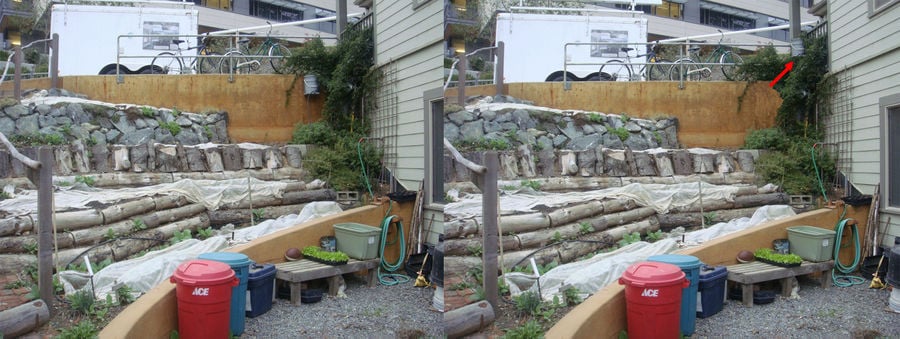
Relocating the storage bucket to the top of the existing retaining wall would increase the system head by about one meter. The proposed new location for the bucket would also allow for easier access and maintenance of the system. Accessing the bucket at its current location requires users of the system to carefully walk amongst the garden plants resulting in a higher potential for crop damage by trampling as well as increased soil compaction.
- Eliminate excess length of main water line, T-fitting, and 90 degree bend in the main water line
The frictional losses in the system would be reduced by eliminating the excess length in the line.[4] The current system has an estimated ten meters of line coiled and laying in the garden bed area (Figure 8). The elimination of this coiled line would also increase the aesthetic value of the system. The system storage tank is not large enough to supply more than one main line at a time. Eliminating the T-filling and replacing it with a single line at the outlet of the storage bucket would increase volume of delivery per plant. The 90-degree bend fitting in the existing line has no apparent use and should also be eliminated from the system to reduce losses.
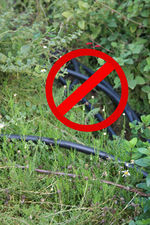
The current system is using emitters designed to be used with pressurized irrigation systems. The system would benefit by replacing the existing emitters with short path or "flag" emitters. The flag emitter is designed for use in systems with very low pressure such as gravity fed drip systems.
- Install stabilizers on main water line to reduce vertical splining of the water line
The installation of stabilizers on the main water line would reduce dips in the line (Figure 9). The current system has numerous dips in the main water line resulting in considerable head loss. The addition of the proposed hose stabilizers would also eliminate the need for the lateral water lines currently being used to direct the irrigation water to the plants. The hose stabilizers may be placed such that the emitters are located at the desired location to maximize water delivery to the plant.
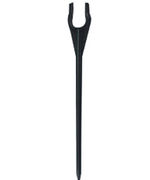
- Replace existing storage bucket with a darker colored bucket
The existing white storage bucket is allowing sunlight to penetrate into the stored water and facilitate algae growth. The algae present in the current system main lines and laterals may be resulting in reduced flow and system performance. Replacing the white storage bucket with a darker colored bucket will decrease the amount of sunlight passing into the stored water and reduce the growth of algae in the system (Figure 10).
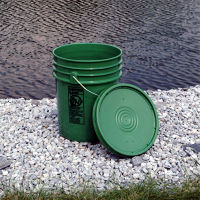
- Include a storage bucket lid in order to eliminate debris contamination of the system
The addition of a lid to the storage bucket will deter larger contaminants, such as leaves and debris, from entering the system. This will result in a more efficient and cleaner flowing system (Figure 10).
- Shorten Lateral Drip Lines
The existing 1/4" lateral drip lines are up to 1 foot in length. These lateral lines are increasing the head requirements of the system and adding to the decreased performance. Shortening the lateral lines and placing them on the under side of the main water lines will further reduce system losses.
- Increase Storage Capacity
The existing five gallon storage bucket is undersized for the current system needs. Increasing the storage capacity of the system may be achieved by replacing the existing five gallon bucket with a larger storage tank or by increasing the number of storage buckets in the system. One option is to supply each garden bed with a separate storage bucket. The existing retaining wall railing has enough space to accommodate up to five buckets. The additional buckets could be placed behind the existing landscaping vegetation increasing the aesthetics of the garden area. Another option to increase the storage capacity of the system would be to tie into the existing CCAT Rainwater Catchment System located uphill from the garden.
- Install filter at storage bucket outlet
The current system is lacking any sort of filter. The lack of a filtering component allows algae and particles to enter the main water line of the system resulting in decreased flow. The addition of a filter at the storage bucket outlet will reduce both fine and coarse particles from entering the main water line of the system. Reducing the concentration of particulate matter in the system will result in increased system performance (Figure 11).
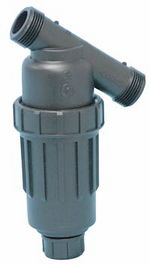
Costs Associated with Proposed Improvements[edit | edit source]
An itemized list of the costs associated with the proposed system improvements is included below (Table 1).
| Quantity | Item | Cost ($) | Total ($) |
|---|---|---|---|
| 1 | 5 gallon bucket and Lid | 7.29 | 7.29 |
| 1 | 3/4" Hose Thread Filter | 11.55 | 11.55 |
| 1 | 100 Feet- Premium Grade 1/2" Polyethylene tubing | 12.99 | 12.99 |
| 1 | 100 Feet- Premium Grade 1/4" Vinyl Micro tubing | 8.29 | 8.29 |
| 35 | 1/4" Barbed Connectors | 0.15 | 5.25 |
| 35 | 1/4" in line shut off valve | 0.69 | 24.15 |
| 35 | 6" Micro tube Stabilizer Stake | 0.25 | 8.75 |
| 1 | Standard Punch - 1/4" Hole | 2.29 | 2.29 |
| 20 | Goof Plug | 0.15 | 3.00 |
| 3 | Perma-Loc Hose Coupling | 0.64 | 1.92 |
| 4 | Perma-Loc Hose Cap | 0.84 | 3.36 |
| 3 | Perma-Loc Hose Tee | 1.62 | 4.86 |
| Total Cost | 93.70 | ||
Update October 2014[edit | edit source]
As of October 2014, the Gravity fed drip irrigation has been retrofitted with new t-fittings and irrigation lines. The old lines were corroded, leaky and clogged with debris. The system is operating fine now however, the irrigation system is no longer gravity fed, it is pressure fed from a garden hose hookup at the top of the trellised garden. A source who uses the irrigation system at CCAT says that the irrigation lines were connected to the rainwater catchment system but the hookup did not produce the gravitational force necessary to efficiently get water out of the lines. Another problem with the rainwater catchment system is it did not successfully remove all of the large debris from the water which would then get clogged in the irrigation lines. This blockage prevented some lines from producing water at all. With the garden hose hookup, the system gets more than enough water volume and pressure running through it to function correctly. The CCAT workers use the irrigation system once a week for 20min in the winter and 2-3 times a week for 20-30min in the summer months. The garden hoses were being used at the time I investigated the irrigation system so I could not try it out for myself. The source I spoke with assured me the lines were dripping water without a problem and the system has never been better since the introduction of the garden hose attachment.
Glossary of Terms[edit | edit source]
- Emitter: Device used to extrude water[11]
- Frictional Losses: Pressure lost by water due to friction between water and the pipe while moving through the line[4]
- Head: Internal energy of a fluid due to pressure exerted on the water surface[12]
- Lateral Lines: Smaller water lines that originate at the main water line used to deliver water to the plant[13]
- Main Line: Larger water line that originates at the storage container[14]
References[edit | edit source]
- ↑ 1.0 1.1 1.2 1.3 1.4 1.5 1.6 1.7 Photos by Garrett McElroy: Fall 2009.
- ↑ Wikipedia.org. Accessed online December 9th, 2009. http://en.wikipedia.org/wiki/Arcata,_California#Climate
- ↑ 3.0 3.1 3.2 Do It Yourself Bucket Drip Irrigation. Accessed online December 9th, 2009. http://web.archive.org/web/20141014161607/http://www.csupomona.edu:80/~jskoga/dripirrigation/
- ↑ 4.0 4.1 4.2 4.3 Munson, B. R., Young, D. F.,& Okiishi, T. H. (2002). Fundamentals of Fluid Mechanics (4th ed.). John Wiley & Sons, Inc.
- ↑ The Drip Store Gravity Feed Systems. Accessed online December 9th, 2009. http://web.archive.org/web/20101125205444/http://www.dripirrigation.com:80/drip_irrigation_help.php?pgv=Gravity
- ↑ Irrigation Tutorials Drip Emitter Spacing. Accessed online December 9th, 2009. http://www.irrigationtutorials.com/drip-spacing.htm
- ↑ 7.0 7.1 Irrigation Tutorials. Accessed online December 9th, 2009. http://www.irrigationtutorials.com/drip-emitter.htm
- ↑ TheGarden.co.uk. Accessed online December 9th, 2009.http://www.thegarden.co.uk/stock images/1111886.jpg
- ↑ US Plastics Corp. Accessed online December 9th, 2009.http://www.usplastic.com/pdfdatafiles/images/greenbucket.jpg
- ↑ The Drip Store. Accessed online December 9th, 2009.http://web.archive.org/web/20060318023306/http://www.dripirrigation.com/popup image.php?pID=121
- ↑ Wikipedia.org. Accessed online December 9th, 2009. http://en.wikipedia.org/wiki/Emitter
- ↑ Wikipedia.org. Accessed online December 9th, 2009. http://en.wikipedia.org/wiki/Hydraulic_head
- ↑ Merriam Webster Online Search. Accessed online December 9th, 2009. http://m-w.com/dictionary/lateral
- ↑ Merriam Webster Online Search. Accessed online December 9th, 2009. http://m-w.com/dictionary/main
![Figure 2: The existing 5-gallon storage bucket is the system's water source. The storage bucket is mounted to the retaining wall above garden beds.[1]](/w/images/thumb/1/16/CCAT_bucket.jpg/200px-CCAT_bucket.jpg)
![Figure 4: The hose clamp used for the gravity fed drip system.[1]](/w/images/thumb/1/1b/Hose_clamp_gem.jpg/200px-Hose_clamp_gem.jpg)
![Figure 3: The T-fitting located at the storage bucket outlet splits the main water line to allow watering of multiple beds.[1]](/w/images/thumb/e/ec/CCAT-t-tap.JPG/200px-CCAT-t-tap.JPG)
![Figure 5: The existing storage bucket has debris and algae growth in standing water.[1]](/w/images/thumb/8/8b/Bucket_Sludge.jpg/200px-Bucket_Sludge.jpg)
![Figure 6: The lateral lines branch off the main water line and are designed to deliver water to individual plants.[1]](/w/images/thumb/2/22/Drip_line.jpeg/200px-Drip_line.jpeg)




